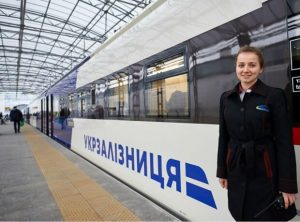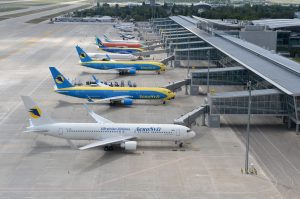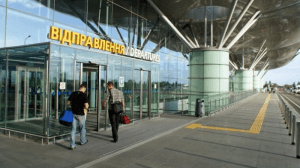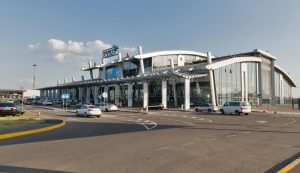
JSC Ukrzaliznytsia notes an increase in passenger traffic and ticket sales since the beginning of 2021 compared to the autumn-winter period of 2020.
According to chairman of the board Volodymyr Zhmak, in the first week of February 2021 the company carried 357,600 passengers, which is 40% more than in mid-December 2020, and the number of tickets sold increased by 9%, to almost 440,000.
“The trend has begun to change – we are increasing passenger traffic and ticket sales compared to the autumn months of 2020. Of course, we are far from the pre-COVID level, but we are moving in a positive trend. Thanks to what? Thanks to innovative approaches to the formation of new trains, the opening of new routes, optimization of traffic – we are reducing the time for trains on many routes,” Zhmak said.

Boryspil International Airport in January-February 2021 reduced passenger traffic to 672,100 people, which is 65.5% less than in January-February 2020.
As the press service of the airport told Interfax-Ukraine, on international flights, in particular, passenger traffic amounted to 606,500 people (less by 66.2%), on domestic – 65,600 people (less by 57.4%).
In February 2021, passenger traffic amounted to 338,300 people (less by 62.4%), of which on international flights – 305,500 people (less by 63.1%), and on domestic flights – 32,800 people (less by 55.1%).
According to the press release, in general, in January-February 2021, the airport served 6,648 flights (less by 54.5%) for arrival/departure, including international – 5,185 flights (less by 59.4%), and domestic – 1,463 flights (less by 21%). At the same time, in February, the number of serviced flights was 3,168 (less by 54.4%) for arrival/departure, including international – 2,477 flights (less by 58.9%), and domestic – 691 flights (less by 24.6%).
The volume of cargo handled by the airport in two months of 2021 decreased by 15.8%, to 5,700 tonnes.
From arrival flights, 4,067 tonnes were handled (6.6% less than in the same month of the previous year), and for departure flights – almost 1,626 tonnes (32.4% less). At the same time, only 101 kg (97.4% less) on arrival and 779 kg (94.8% less) on departure were handled on domestic flights. Everything else is international.
The volume of serviced mail amounted to 968.3 tonnes, which is 37.8% less than in January-February 2020. The volume of arrived postal items decreased by 58.3% (to 410.1 tonnes), and the number of postal items sent from Ukraine decreased by 2.7% (to 558.2 tonnes).
Boryspil International Airport is the largest airport in Ukraine with a total occupied area of about 1,000 hectares. It has two runways: the one is 4,000 meters long and 60 meters wide, the second is 3,500 meters long and 63 meters wide. There are four passenger terminals and a postal and cargo complex on its territory.

Boryspil International Airport (Kyiv) in 2020 reduced passenger traffic by 66.2% compared to 2019, to 5.158 million people.
The press service of the airport told Interfax-Ukraine that 4.69 million people on international flights were serviced (a decrease by 66.9% compared with the last year), and 468,100 on domestic flights (57.3% less).
The number of arrival/departure flights serviced by the airport in 2020 amounted to 46,850 (57.7% down), including 38,376 international flights (60.6% down), and 8,470 domestic one (36% down).
The number of cargo handled by the airport in 2020 fell by 10%, to 37,790 tonnes, while in December 2020 the airport handled 4,273 tonnes of cargo.
In December 2020, Boryspil’s passenger traffic decreased by 69.3% compared to December 2019 and amounted to 323,700 passengers. At the same time, 286,500 people were serviced on international flights (70.6% less), 37,200 on domestic one (53.8% less).
The number of arrival and departure flights in December 2020 amounted to 3,575 (54.2% down), including 2,728 international flights (60.3% down) and 847 domestic flights (9.4% down).
BORYSPIL, BORYSPIL AIRPORT, BORYSPIL INTERNATIONAL AIRPORT, PASSENGER TRAFFIC

Passenger traffic at Kyiv Sikorsky International Airport in January-November 2020 amounted to 670,900 passengers, which is 72.2% less than in the same period in 2019.
According to the airport’s website, the number of passengers served on international flights amounted to 656,200, on domestic – 14,700.
The number of flights in January-November 2020 amounted to 11,820 for arrival/departure, which is 53.8% less than the same period in 2019, of which international flights amounted to 9,430, domestic to 2,390.
The most popular international destinations since the beginning of 2020 were Warsaw (Poland), Minsk (Belarus), Berlin (Germany), Vienna (Austria), London (the United Kingdom), Memmingen and Dortmund (Germany), domestic – Zaporizhia, Dnipro and Odesa.
In November 2020, the airport served 24,200 passengers, which is 86.6% less than in November 2019. The number of passengers served on international flights was 22,400, domestic flights – 1,800 passengers.
The number of flights in November 2020 was 865 for arrival/departure, which is 57.4% less than in the same period in 2019, of which international flights were 680, domestic – 185.
The most popular international destinations in November 2020 were Vilnius (Lithuania), Warsaw (Poland), Dortmund (Germany), Berlin (Germany), London (the United Kingdom), Copenhagen (Denmark), Gdansk (Poland); internal – Zaporizhia, Lviv and Odesa.
KYIV AIRPORT, Kyiv Sikorsky International Airport, PASSENGER TRAFFIC

Ukrzaliznytsia plans to receive UAH 17.6 billion in revenue from freight traffic in October-December 2020, which is 7.98% more than in the previous quarter.
This is a record quarterly indicator of financial receipts this year from the main business of the company, Ukrzaliznytsia said.
So, in the first quarter of this year, Ukrzaliznytsia’s income from freight traffic amounted to UAH 16.6 billion, in the second – UAH 14.6 billion, and in the third – UAH 16.3 billion.
“Ukrzaliznytsia will be able to achieve a record level of income in the fourth quarter due to increased efficiency of the company’s operating activities, liquidation of the locomotive shortage, improved dispatching and fruitful cooperation with all participants in the transportation process,” the message says.
The company also clarified that in September 2020, the company’s income from domestic freight rail transportation increased by 6% compared to the same period in 2019 – up to UAH 2.1 billion, and in October – by 3.2% against October 2019 and amounted to UAH 2.2 billion.

Passenger traffic at Boryspil International Airport decreased by 65% in January-October 2020 and amounted to 4.53 million people.
As the airport said on its Facebook page on Monday, the number of transfer passengers decreased by 84.9% to 435,500, the number of flights by 57.9% to 39,800.
In October 2020, the airport served 472,500 passengers (less by 67.3%), of which 17,400 (84.9% less) were transfer.
The number of flights was more than 4,300 (56.9% less) in the past month.
As reported, Boryspil International Airport in 2019 increased passenger traffic by 21.1% to 15.260 million people compared to 2018.
Boryspil International Airport is the largest airport in Ukraine with a total occupied area of about 1,000 ha. It has two runways: the one is 4,000 meters long and 60 meters wide, the second is 3,500 meters long and 63 meters wide. There are four passenger terminals and a postal and cargo complex on its territory.
BORYSPIL AIRPORT, BORYSPIL INTERNATIONAL AIRPORT, PASSENGER, PASSENGER TRAFFIC